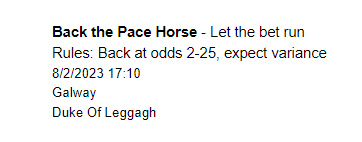The BTC Horse Racing Thread
-
@Dan-MacKinnon as long as it doesn't change anything I don't see anything wrong in checking results but I do get the temptation!
-
@Martin said in The BTC Horse Racing Thread:
Had first losing day since using automation yesterday on the horses, much easier to take isn't it you don't let emotion get involved at all.
Onto Cincinnati!
You will have plenty more.

 Got kicked on the lbtf yesterday. Not that I knew anything about it. Went to see Barbie in the morning(Margot Robbie
Got kicked on the lbtf yesterday. Not that I knew anything about it. Went to see Barbie in the morning(Margot Robbie  ) and Oppenheimer in the afternoon(Emily Blunt
) and Oppenheimer in the afternoon(Emily Blunt ). Barbie surprisingly better than I thought. Oppenheimer really intense.
). Barbie surprisingly better than I thought. Oppenheimer really intense. -
@Martin yeah I find it a lot easier to deal with bad days. My only trouble is I told myself I won’t check the results until the weekend, and then I’m checking it all the time.
I think I need to ban myself and check it once and that’s it
-
-
@Correa Lay 3rd Fav.gz
-
@Martin said in The BTC Horse Racing Thread:
@Correa keep an eye on the Irish Dobs and Lay 3rd Fav had a very good first week of forward testing for me so far.
@Martin Will do. I think I've seen the BFBM bot somewhere in the forum for the Lay 3rd Fav strategy, but I can't find it. Would you mind sharing it again? Thanks!!!
-
After a terrible start, backing the favourite is making a comeback. I'm wondering if the past two days of rain could greatly influence this strategy.
-
@Robert-Tabbenor said in The BTC Horse Racing Thread:
trawl
you would need to create the file if it's not here.
These are the ones I have, give them a look though these aren't strategies I use so they will need checking they work and staking etc looked at. drive-download-20230803T070557Z-001.zip
-
@Martin Profit today on lay the dobs £20 so a good start! I have just set up Irish dobs so see how that goes tomorrow. I was going to use the lay the fav strategy and got it all set up but cant find the GZ file for that and the other strategies. Is there a specific place for them or a tutorial on how to set up GZ files? Thanks, Rob
-
@Jordan-Carling said in The BTC Horse Racing Thread:
How come the back the pace horse strategy has a pace rating restriction of 8,10,12 but in the daily qualifiers I’m getting some selections of 4 and 6 in there?
we had one selection today and the pace rating was 10


